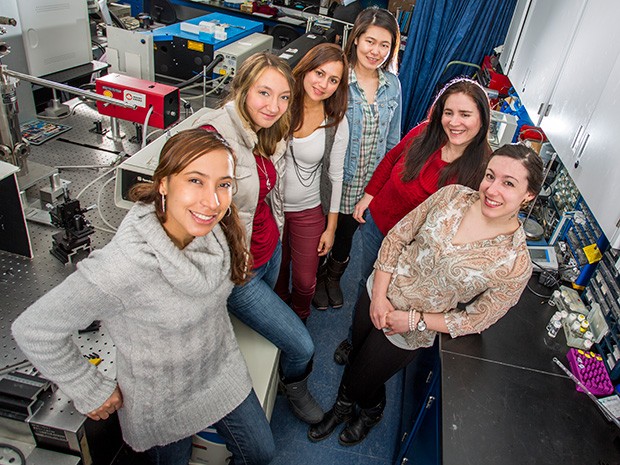The Concordia lab that is changing how we detect cancer cells
The students in John Capobianco’s Lanthanide Research Group have a lot in common.
They’re passionate about chemistry, with the scholarships and awards to show for it. Most came from outside Canada to study at Concordia, some from as far away as Colombia, China and Romania. And all but one are women.
To Capobianco, a professor in the Department of Chemistry and Biochemistry, that last detail is a big leap from the not-so-distant past. In his undergraduate days, he says, there were only one or two women in each of his science classes. But now, things are different.
“Even with respect to faculty, in chemistry and biochemistry, we have seven women faculty members,” he says. “It’s a welcome change.”
Of the nine students in Capobianco’s Lanthanide Research Group, eight are women.
Their numbers include Diana Consuelo Rodríguez Burbano, a PhD candidate from Colombia. As a child, Rodríguez Burbano — who is supported by Concordia’s Stanley G. French Graduate Fellowship and a scholarship from the Colombian government — spent a lot of time around labs.
Her mother is a molecular biologist at the National University of Colombia. It seemed natural, then, for her to pursue a similar career path.
Rodríguez Burbano’s research is driven by her desire to help humanity.
“I believe science must have an application that benefits society,” she says. “In the lab, we do the studies and develop the theories, and then we do the synthesis and the characterization — right through to the research’s final application, which is biomedical.”
A culture of innovation
Right now, the research group is exploring new ways to use lanthanide-doped nanoparticles for bioimaging, and as a detection tool for targeting cancer cells.
That sort of innovation has long been part of Capobianco’s work. “We were the first to observe upconversion in nanoparticles in the late 1990s,” he says.
These upconverting nanoparticles, which can be synthesized in the lab, render near-infrared light visible. “With that, we started looking at using some of the potential applications of upconversion with lanthanides, and it’s just rolled along since.”
Jessica Yu, a master’s student, has been experimenting with the use of upconverting nanoparticles in photodynamic therapy — an effort that could one day yield groundbreaking results.
“The more I do this research, the more I realize that this is something that can help people,” she says. “It really could have a significant impact on the world.”
The current crop of lanthanide researchers are among the best students Capobianco has ever had. “They’re not just doing very interesting science,” he says. “They’re also giving back to society.”
Meet the Lanthanide Research Group
The members of the Lanthanide Research Group are pursuing a wide range of projects. Here’s a taste of what they’re working on — and what they hope to achieve.
PhD student Diana Consuelo Rodríguez Burbano is looking at the use of electron-trapping nanoparticles, also known as nanophosphors, to identify and target cancer cells. This kind of treatment allows for deeper tissue penetration than typical UV technology, but with less tissue damage.
Master’s student Jessica Yu is experimenting with using upconverting nanoparticles in photodynamic cancer treatments. The goal, she says, is to get deep in the body to target the most cancer cells possible.
Paola Andrea Rojas Gutiérrez, a PhD student who received both a Concordia International Tuition Fee Remission Award and a privately funded scholarship from her native Colombia, is looking at new ways to use nanoparticles as a drug-delivery system.
Ying Li, another master’s student, is examining the use of nanoparticles as a bimodal imaging contrasting agent, which would allow them to be seen both optically and through the use of magnetic resonance imaging.
Visiting PhD student Malgorzata Misiak is working on a research collaboration between Concordia and her home institution, Poland’s University of Wrocław in Poland. She is also looking at a specific application of lanthanide-doped nanoparticles in photodynamic therapy to treat cancer.
PhD candidate Ana Maria Ibarra Ruiz, a new student, who received both the Frederick Lowy Scholars Fellowship and an Arts and Science Graduate Fellowship, is still working out the direction of her research project. She previously worked with lanthanides in Colombia. “The research that I did there wasn’t as applied, though. I find this research a lot more interesting for that reason.” She will be working on using quantum dots and upconverting nanoparticles to construct hybrid luminescent probes.
Two undergraduate students, Rebecca Webb and Andrew Dalton, also work in the lab, as does post-doctoral researcher Nicoleta Bogdan, who hails from Romania. “It’s a great opportunity for me to work in spectroscopy and luminescence,” she says. “And working with nanoparticles is something that’s always interested me.”
